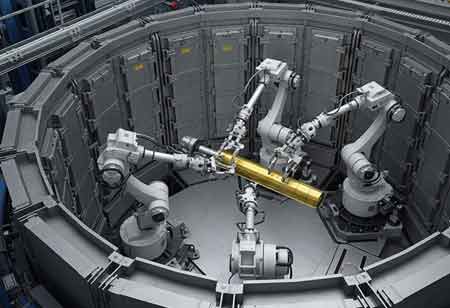CLOSE
Specials
I agree We use cookies on this website to enhance your user experience. By clicking any link on this page you are giving your consent for us to set cookies. More info
Be first to read the latest tech news, Industry Leader's Insights, and CIO interviews of medium and large enterprises exclusively from Energy Tech Review
Thank you for Subscribing
ACHE Innovation at the Heart of APAC's Sustainable Expansion
The APAC air-cooled heat exchanger market is experiencing rapid expansion, driven by industrialization, sustainability, and technological advancements, which highlights a growing demand for efficient cooling solutions.

By
Energy Tech Review | Tuesday, June 24, 2025
Stay ahead of the industry with exclusive feature stories on the top companies, expert insights and the latest news delivered straight to your inbox. Subscribe today.
The Asia-Pacific (APAC) region stands at the forefront of industrial expansion and technological advancement, driving a robust and rapidly evolving market for air-cooled heat exchanger (ACHE) solutions. With its diverse economies, burgeoning manufacturing sectors, and increasing focus on energy efficiency and sustainability, APAC is demonstrating an unparalleled demand for thermal management systems that operate independently of water resources.
Market Dynamics and Growth Drivers
The APAC air-cooled heat exchanger market is experiencing significant growth, projected to continue its strong upward trajectory into 2025 and beyond. This expansion is primarily driven by the rapid pace of industrialization and urbanization in major economies such as China, India, and the rapidly developing nations of Southeast Asia. These regions are witnessing a surge in new industrial installations, particularly within the petrochemical, oil and gas, and power generation sectors, all of which are heavy consumers of heat exchange solutions.
A primary driver for the increased adoption of ACHEs in APAC is the growing emphasis on energy efficiency and environmental sustainability. As industries strive to lower their operational costs and comply with evolving environmental regulations, the inherent water-saving capability of air-cooled systems makes them an increasingly attractive option. In a region where water scarcity is a growing concern in many areas, the ability of ACHEs to dissipate heat without relying on a continuous water supply offers a significant advantage. This minimizes water procurement and treatment expenses, aligning with broader corporate sustainability goals. The demand for eco-friendly heat exchangers is demonstrably on the rise, contributing to a substantial portion of newly installed units featuring energy-efficient designs.
Technological Advancements Shaping the Future
One significant trend is the shift towards advanced materials. Manufacturers are increasingly adopting corrosion-resistant and durable materials, such as stainless steel, which is gaining prominence due to its robustness in harsh environments, including those found in chemical plants and coastal operations. Although the initial cost may be higher, its extended service life and reduced maintenance needs provide substantial long-term value. Carbon steel remains widely used due to its strength and cost-effectiveness in environments with less corrosive conditions. Cutting-edge materials such as graphene and ceramics are being explored for their superior thermal conductivity and resistance properties, offering the potential for even more efficient and resilient ACHE systems.
Design optimization is another area of focus, particularly in fin technologies that significantly influence heat transfer efficiency. G-fin designs currently dominate the market, delivering high thermal performance and an expanded surface area for enhanced heat dissipation, particularly in high-temperature and high-pressure environments such as oil and gas and power generation. Ongoing research into L-fin and LL-fin alternatives aims to reduce airflow resistance further and improve energy efficiency. Similarly, advancements in fan technologies are yielding substantial gains in operational efficiency. New fan designs contribute to reduced power consumption, lower noise levels, and improved airflow. Induced draft systems, in particular, are becoming increasingly prevalent due to their ability to enhance heat exchange performance in high-temperature settings while also providing better protection against environmental exposure.
The adoption of innovative and IoT-enabled technologies is transforming the ACHE landscape. Integrated sensors and IoT-based monitoring systems offer real-time performance tracking, enabling predictive maintenance and energy optimization. This not only reduces unplanned downtime but also enhances overall operational efficiency. The growing emphasis on industrial automation across the APAC region is accelerating the demand for AI-driven maintenance solutions. Automated self-cleaning systems are emerging to prevent fouling and scaling, thereby further minimizing the need for manual interventions.
The market is witnessing a rise in modular and customized ACHE designs. These solutions are tailored to meet specific industrial requirements, offering flexibility, ease of installation, and simplified maintenance. Modular systems, in particular, provide scalable configurations that can adapt to changing operational demands, making them an increasingly attractive option for a wide range of industrial applications.
Applications Across Key Industries
ACHE solutions play a vital role in supporting a diverse range of industries across the region by enabling efficient cooling and heat rejection processes. In the oil and gas, as well as petrochemical sectors, ACHEs are essential components in refineries, natural gas processing facilities, and petrochemical complexes. These exchangers are relied upon to cool process fluids, condense vapors, and maintain operational stability under extreme conditions. The sector’s demanding environments continue to drive innovation in ACHE design and material engineering, ensuring durability and performance.
In power generation, particularly within thermal power plants, ACHEs are extensively used for turbine cooling and condensation. As energy demand continues to rise across the APAC region, supported by investments in both conventional and renewable energy infrastructure, the power sector remains a major consumer of air-cooled technologies. Moreover, the growing emphasis on waste heat recovery presents new opportunities for the deployment of advanced ACHE systems.
The HVAC and refrigeration industry is also experiencing increased demand for air-cooled solutions, driven by rapid urbanization and construction growth throughout the region. ACHEs are core to large-scale air conditioning systems and industrial refrigeration applications, providing efficient temperature control in commercial, residential, and industrial environments.
In the chemical industry, ACHEs are employed to cool reactors, condensers, and various process streams. Given the often corrosive and complex nature of chemical operations, these exchangers are designed with specialized materials to ensure reliability, safety, and resistance to degradation.
The proliferation of data centers across the region, fueled by digital transformation and the rise of AI and machine learning, has intensified the need for effective cooling solutions. While liquid cooling is gaining traction for high-density setups, air-cooled systems remain essential for broader data center cooling strategies, especially where energy efficiency and water independence are critical considerations.
The APAC air-cooled heat exchanger market is poised for continued industrial expansion, coupled with a persistent focus on sustainability and technological innovation, which will underpin this trajectory. The increasing integration of smart technologies, the development of advanced materials, and the emphasis on customized, high-efficiency solutions will define the next generation of ACHEs in the region. This future is not just about growth, but also about the exciting potential for innovation in ACHE design and material science. This journey promises to be both challenging and rewarding.

Copyright © 2025 Energy Tech Review. All rights reserved






